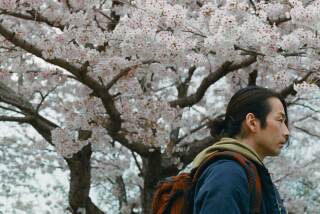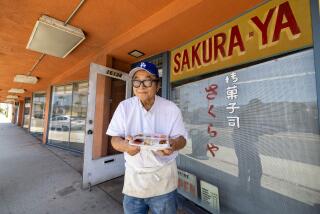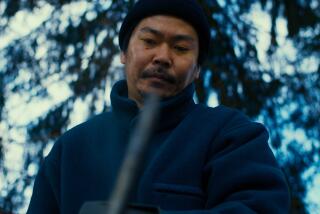Goro Miyazaki sets his own path in animation
On his first trip to Los Angeles in February, Japanese director Goro Miyazaki found a native custom perplexing.
“I’ve never been to any other place in the world where you see so few pedestrians,” Miyazaki said, speaking through a translator in a rare interview at his Beverly Hills hotel. “Normally I go for a walk every morning, but I was told that if I’m just walking around, people will see me as somebody strange.”
Miyazaki is accustomed to moving to a different tempo. He’s the son of Hayao Miyazaki, the so-called Walt Disney of Japan, whose fantastical, hand-drawn animated films such as “Spirited Away,” “Howl’s Moving Castle,” “Ponyo” and “Princess Mononoke” have made him his country’s most successful filmmaker and a defiantly old-school hero in a global boom era for computer animation.
Soft-spoken and stoic, Goro represents the new guard at Hayao’s 28-year-old Tokyo-based company, Studio Ghibli. Now on his second feature film, the younger Miyazaki has assumed his responsibility with reservation, both because of complex filial feelings and his fears about the future of a fading art form.
“[Goro’s] is the fate of one who has a legendary father,” said longtime Studio Ghibli producer Toshio Suzuki, through a translator. “For Goro, Hayao Miyazaki is not a father but rather a tall wall.”
Studio Ghibli’s latest entry, “From Up on Poppy Hill,” teams father and son. The period drama co-written by Hayao, 72, and Keiko Niwa and directed by Goro, 46, opens in Los Angeles on March 22. Based on a 1980 comic book by Chizuru Takahashi and Tetsuro Sayama, “From Up on Poppy Hill” is set in the seaside city of Yokohama in 1963, when high school students band together to save an old building from demolition.
With naturalistic animation of ocean vistas, burgeoning cityscapes and mouth-watering home-cooked meals, the movie places two romances at its center — one between a pair of teen characters and another between the movie’s Japanese audience and its history.
“There’s a strong sense of nostalgia for this period of time in Japan,” the younger Miyazaki said. “You have the terrible period of World War II, and that was followed by chaos. The period we’re talking about here is right before economic growth, and that was the brief moment in Japan when people were able to enjoy a relative time of peace and calmness.”
The nostalgia on screen belongs not to Goro’s generation but to his father’s — “I believe it was a gift from father to son,” Suzuki said of the script. Goro believes it was an opportunity for his father to experiment with a period film in advance of his next feature, “The Wind Rises,” about a designer of World War II fighter planes and due to open in Japan this year (Miyazaki’s family made wing tips during the war).
Realizing Hayao’s ideas while articulating his own was one of Goro’s chief challenges on the film.
“[Hayao] had planned and developed the screenplay, so he comes in with a particular vision, and I have to deal with that to an extent,” said Goro, married with a 4-year-old son. “Whenever you have somebody who’s as experienced as he is with filmmaking and somebody who’s as relatively new to this as I am, you’re gonna have a huge gap in sheer ability. That’s another thing I always had to grapple with. Whether it’s a good advice or bad advice, he would always come in and offer suggestions. Those have a huge impact on us. The challenge for us was not to be swayed too much by those comments, to be able to push back.”
While making the film, Studio Ghibli’s animators lived through another catastrophic event in Japan’s history: the 2011 magnitude 9 earthquake off the country’s east coast that triggered powerful tsunami waves, nuclear accidents and rolling blackouts. “From Up on Poppy Hill” was about half-finished when the earthquake hit, according to Goro, and the blackouts delayed the animation process. (Although the company relies on hand-drawn animation, those drawings are still put together on computers.)
“While most of us were not personally affected by the disaster, there were a lot of us who did go through a period of mental affectedness because of what happened and that took some time to recover from,” Goro said.
Growing up, Goro and his younger brother sometimes found sketches of their parents’ work around the house — their mother is also an animator. But Goro didn’t want to follow the family trade, pursuing instead an interest in landscape architecture — to this day, for fun he said he likes to pull weeds from his garden.
“When I was in high school, I was thinking if I were to choose the same path as my father I would never be able to reach the level he has attained,” Goro said. “I thought it would be better to choose my own path.”
It was when Goro was working on an exhibit at the Studio Ghibli museum that Suzuki enlisted him to draft storyboards for a film in the works at the studio at the time, an adaptation of a series of fantasy novelist Ursula K. Le Guin’s books. Impressed by Goro’s ideas and sketches, Suzuki asked him to direct the film, “Tales From Earthsea,” a Herculean task for someone with zero feature animation experience.
“At the time I was too ignorant to be nervous,” Goro said. “But I did have a very clear vision of what I wanted out of the film. And we do have very talented artists at Ghibli, so what I focused on was to be able to communicate as clearly as possible to them what I was looking for and to trust them.”
The movie, an allegory about global warming with dragons and sorcerers released in Japan in 2006 and the U.S. in 2010, premiered to mixed reviews, with critics calling it too earnest. “Tales From Earthsea” grossed $68 million worldwide, less than $50,000 of it from the U.S.
Critics have been kinder to “From Up on Poppy Hill,” which has made $48 million in Japan since its premiere there in 2011. Critics there praised the wealth of period detail, while reviewers from Variety and the Hollywood Reporter singled out the film’s visuals and songs. The version being released in North America, voiced by Sarah Bolger, Anton Yelchin, Gillian Anderson, Beau Bridges and others, has not been reviewed by critics.
With its specific Japanese story, the film is likely to play to smaller audiences here. “Even if we tried to make a movie for an international audience I don’t think we’d understand it well enough to do it properly,” Goro said. “Our philosophy is that we should gear it to the audience we know best, and that is Japan.”
Studio Ghibli is operating at full tilt, with 250 employees working on two 2013 films, Hayao’s “The Wind Rises” and “The Tale of the Princess Kaguya” by his longtime creative partner, Isao Takahata.
Nevertheless, Goro is nervous about what’s to come.
“To be honest I don’t think it’s a bright future,” he said. “With animation, people who have the capacity to direct right now are over 40 years old. There’s a shortage of talented young animators. It feels to me like the golden age of animation may be coming to an end.”
MORE FROM HERO COMPLEX
HERO COMPLEX: Pop culture unmasked
PHOTOS: 60 images from ‘The Hobbit’
VIDEO GAMES: The latest news and reviews
More to Read
Only good movies
Get the Indie Focus newsletter, Mark Olsen's weekly guide to the world of cinema.
You may occasionally receive promotional content from the Los Angeles Times.











